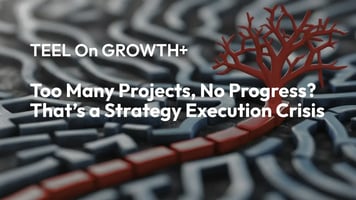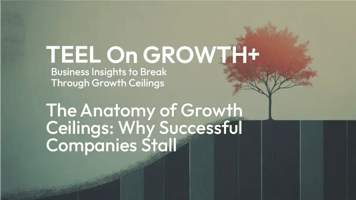Why global success stalls in the U.S.—and how localization fixes it Executive Briefing Global...
Misaligned Roadmaps Are Costing You Tech Revenue
When engineering excellence misses market reality—and revenue
Executive Briefing
Great technology fails when it solves the wrong problem. In my work with scaling tech companies, I've seen brilliant engineering teams build sophisticated products that miss the market entirely—not because the technology isn't good, but because the roadmap ignores buyer voice.
The most common failure pattern? Engineering-led product decisions that prioritize technical elegance over market relevance. Companies chase feature complexity while buyers want outcome simplicity. The result: stalled ARR growth, declining conversion rates, and roadmaps that consume resources without generating revenue.
The core issue: Product roadmaps that aren't aligned with Ideal Customer Profile (ICP) needs create a destructive cycle. Engineering builds features that don't drive adoption. Sales struggles to articulate value. Marketing can't create compelling messaging. Revenue stagnates despite continued product investment.
The solution requires three integrated shifts: Split roadmaps between core scalable features and client-specific customization. Elevate go-to-market (GTM) input in product decisions through joint steering committees. Embed structured buyer feedback loops into development cycles.
Companies that achieve ICP-driven roadmap alignment don't just improve product-market fit—they create sustainable competitive advantages through faster feature adoption, higher Net Promoter Scores, and predictable revenue growth from existing customers.
AFTER TWENTY YEARS of working with technology companies—as a CFO for global tech firms and now advising mid-market technology companies—I've identified a pattern that kills more promising tech businesses than funding gaps or competitive threats: brilliant technology solving the wrong problem.
During my CFO tenure, I watched this dynamic destroy value from the inside. Engineering teams would build remarkable products while I tracked the financial metrics that revealed the truth: declining conversion rates, stagnant ARR growth, and feature development costs that never translated into revenue expansion. The issue isn't engineering capability—it's strategic misalignment between roadmaps that prioritize technical sophistication and markets that demand outcome relevance.
Let me tell you about a $15M SaaS company I worked with recently. Exceptional engineering team. Innovative product architecture. Eighteen months of declining conversion rates despite aggressive feature releases. Their problem wasn't technology quality—it was roadmap strategy that had drifted away from buyer needs toward engineering preferences.
When we analyzed their feature usage data, 60% of new capabilities had adoption rates below 15%. Their roadmap was engineering-led, not market-driven. They were solving problems that excited developers but didn't matter to buyers.
The Customization Trap
The most dangerous pattern I see in scaling B2B tech companies is roadmap chaos created by chasing large customer requests. It starts innocently: a major prospect offers substantial revenue in exchange for specific customization. Engineering agrees because the technical challenge is interesting. Sales pushes because the deal size is attractive.
Here's what actually happens: delivery timelines extend as the team builds one-off solutions. Technical debt accumulates from custom code paths that can't be generalized. Core product development stalls while resources focus on client-specific requirements. The original product vision becomes fragmented across multiple custom implementations.
I worked with a B2B platform company that accepted five major customization requests in their first year of growth. Each seemed reasonable individually. Collectively, they destroyed roadmap coherence. Engineering velocity dropped 40% as the team managed multiple product variants. Customer onboarding became complex because each implementation required different workflows. Technical support costs tripled due to customization-related issues.
The customization trap creates three critical business risks:
Delivery delays compound as engineering complexity increases exponentially with each custom requirement. What should be straightforward feature releases become month-long projects requiring extensive testing across multiple configurations.
Technical debt accumulation occurs when custom solutions can't be integrated into the core platform architecture. The codebase becomes fragmented, making future development slower and more expensive.
Erosion of core value proposition happens gradually as the product becomes harder to explain, demonstrate, and support. Sales cycles lengthen because prospects struggle to understand how customization affects their implementation.
The impact on future scalability is severe. Companies trapped in customization cycles struggle to develop platform capabilities that serve broader markets. They become services businesses disguised as software companies, with economics that don't support sustainable growth.
Engineering-Led vs. Market-Led Product Thinking
Most technology companies suffer from a fundamental strategic misalignment: product direction owned by engineering or founders rather than market feedback. This creates roadmaps that optimize for technical elegance instead of buyer outcomes.
Engineering-led product thinking prioritizes architectural consistency, technical innovation, and feature sophistication. These are important considerations, but they don't predict market success. I've seen beautifully architected products with zero market traction because the features addressed engineering challenges rather than customer problems.
The consequences are predictable: features nobody uses. A cybersecurity platform I analyzed had built an advanced threat modeling module that took six months to develop and represented significant technical achievement. Customer usage: 8%. Why? The feature solved a problem that security teams didn't prioritize, using workflows that didn't match their operational reality.
Market-led product thinking starts with structured buyer research, Ideal Customer Profile (ICP) mapping, and systematic feedback collection. This isn't just gathering feature requests—it's understanding the business problems that buyers need to solve and the workflows they use to solve them.
The difference shows up in development priorities and resource allocation decisions:
|
Decision Factor |
Engineering-Led |
ICP-Driven |
|
Primary Input |
Technical feasibility |
Buyer feedback loops |
|
Success Metric |
Feature complexity |
Adoption rates |
|
Resource Allocation |
Even distribution |
Market-weighted priority |
|
Development Cycle |
Technology capabilities |
Customer outcomes |
|
Risk Assessment |
Technical debt |
Market misalignment |
Engineering-led teams build features that are technically interesting.
Market-led teams build capabilities that drive measurable buyer outcomes.
The latter approach creates products that sell themselves through demonstrated value rather than requiring extensive sales education.
Messaging Disconnect
Technical specifications don't sell outcomes. Yet most technology companies structure their messaging around feature capabilities rather than business results. This creates a fundamental disconnect between what engineering builds and what buyers actually want to purchase.
Buyers want results, not features. They need to understand how your technology improves their business metrics—increased efficiency, reduced costs, faster time-to-market. They don't care about your system architecture, programming language choices, or technical performance benchmarks unless those elements directly impact their operational outcomes.
Let me illustrate with a buyer persona mismatch example. An enterprise software company was targeting IT directors with messaging focused on API flexibility, database performance, and integration capabilities. Their conversion rates were disappointing until we discovered that IT directors weren't the real decision-makers. The actual buyers were department heads who needed to understand business process improvements, not technical infrastructure benefits.
We restructured their messaging to address business outcomes: "Reduce manual data entry by 75%" instead of "Advanced API integration capabilities." "Decrease report generation time from hours to minutes" rather than "High-performance database optimization." Conversion rates improved 40% within two quarters.
The messaging disconnect compounds when product roadmaps aren't informed by buyer voice. Engineering builds features that seem valuable from a technical perspective, but sales can't articulate their business relevance. Marketing struggles to create compelling content because the feature benefits aren't aligned with buyer priorities.
Strategic Product Governance
Sustainable product development requires governance structures that balance engineering capabilities with market needs. The most effective approach involves splitting roadmaps between core scalable features and client-specific customization, then establishing joint decision-making processes.
Split roadmap architecture creates clear boundaries between platform development and custom solutions. Core features serve the broader market and receive primary development resources. Custom requirements are handled through separate streams with dedicated timelines and resource allocation. This prevents one-off client needs from derailing platform strategy.
Elevate Go-to-Market (GTM) in product decisions through cross-functional, product-focused teams that include engineering, product management, sales, and customer success representatives. These groups review feature requests against ICP alignment, market opportunity size, and competitive positioning—not just technical feasibility.

The integrated approach transforms product development from an engineering exercise into a market-responsive capability. When all teams contribute structured input to product decisions, roadmaps naturally align with buyer needs while maintaining technical integrity.
Embed client feedback loops into backlog grooming through structured research processes. Monthly buyer interviews, quarterly customer advisory board meetings, and systematic feature usage analysis ensure that development priorities stay connected to market reality.
Effective feedback collection requires different approaches across go-to-market functions:
|
GTM Team |
Data Type |
Collection Frequency |
Decision Impact |
|
Sales |
Win/loss analysis, deal feedback |
Monthly pipeline reviews |
High - revenue validation |
|
Customer Success |
Usage patterns, support tickets |
Weekly account reviews |
Medium - adoption insights |
|
Marketing |
Buyer research, competitive intel |
Quarterly market studies |
High - positioning strategy |
|
Business Development |
Partner feedback, integration needs |
Quarterly partner reviews |
Medium - ecosystem alignment |
The governance framework must include decision criteria that weigh market impact alongside technical considerations. Features should be evaluated based on addressable market size, buyer priority levels, competitive differentiation potential, and resource requirements. This prevents engineering preferences from overriding market strategy.
ICP-Driven Roadmaps: A New Operating Standard
The most successful technology companies I work with have shifted to ICP-driven roadmap development that uses both qualitative and quantitative data to prioritize features. This approach segments development efforts by market tier and creates systematic feedback loops between buyer needs and engineering capabilities.
Use qualitative and quantitative data to inform feature prioritization. Qualitative insights come from buyer interviews, customer success feedback, and sales team observations. Quantitative data includes feature usage analytics, customer churn analysis, and conversion rate tracking by feature set. Validate use cases through real customer workflows rather than theoretical scenarios. Combining both perspectives creates comprehensive understanding of what buyers actually value.
Segment roadmap releases by market tier to ensure that development efforts align with revenue opportunities. Enterprise features receive different prioritization than SMB capabilities. Geographic market requirements are balanced against global platform needs. This segmentation prevents roadmap dilution from trying to serve all markets simultaneously.
Show overlap between client pain points and product capabilities through systematic mapping exercises. Monthly reviews assess whether engineering development addresses the most significant buyer challenges. Quarterly analyses evaluate whether product capabilities are translating into customer outcomes.
The ICP-driven approach requires discipline to resist feature requests that don't align with target buyer profiles. It means saying no to interesting technical challenges that don't serve market needs. But companies that maintain this discipline create products that sell more effectively and scale more efficiently.
Case Study: From Stalled ARR to Sustainable Growth
An enterprise software company I worked with had stalled ARR growth despite eighteen months of aggressive feature development. Their challenge: engineering had built sophisticated capabilities that weren't driving customer adoption or revenue expansion.
The situation: Annual recurring revenue had plateaued at $21M despite releasing twenty-three new features in twelve months. Customer adoption rates for new capabilities averaged 18%. Net Promoter Score was declining even as product functionality increased. The engineering team was frustrated because their technical achievements weren't translating into business results.
Changes made: We implemented three systematic improvements:
New research cadence: Monthly buyer interviews with target personas, quarterly customer advisory board sessions, and weekly sales team feedback collection. This created continuous market input into product decisions.
Roadmap segmentation: Split development between core platform features (75% of resources) and enterprise customization (25% of resources). Core features required ICP alignment validation before development approval.
GTM ownership: Established a cross-functional, product-focused team with equal representation from engineering, product management, sales, and customer success. Feature prioritization required unanimous agreement on market relevance.
Results: Within nine months, product adoption rates increased 35% for new features. Net Promoter Score improved from 31 to 47. Most importantly, ARR growth resumed at 25% annually as existing customers expanded usage rather than churning.
The transformation happened because engineering efforts became aligned with buyer outcomes rather than technical possibilities. Features were built to solve customer problems, not to demonstrate engineering sophistication.
Strategic Insight: ICP Alignment as Product Strategy
The most important insight from working with scaling technology companies is that ICP alignment isn't just marketing's responsibility—it's fundamental product strategy. GTM traction begins with roadmap relevance, not sales execution or marketing messaging.
When product development is driven by buyer voice rather than engineering preferences, several business metrics improve simultaneously. Customer acquisition costs decrease because prospects can immediately understand product value. Sales cycles shorten because feature benefits align with buyer priorities. Customer lifetime value increases because adoption drives stickiness.
The competitive advantage of ICP-driven roadmaps compounds over time. Companies that systematically align development with buyer needs create products that are harder to displace. Competitors may copy individual features, but they can't replicate the systematic market intelligence that drives prioritization decisions.
Building this capability requires three organizational commitments:
First, engineering teams must accept market input as legitimate technical requirements, not optional suggestions. This cultural shift often requires leadership modeling and measurement system changes.
Second, go-to-market teams—sales, marketing, customer success, and business development—must provide structured, actionable feedback rather than anecdotal feature requests. This means developing research processes and data collection systems that support engineering decision-making.
Third, product management must become the bridge between technical capabilities and market needs, translating buyer requirements into engineering specifications while maintaining platform architectural integrity.
Conclusion: Revenue Follows Relevance
Great technology companies don't fail because of engineering inadequacy—they fail because of roadmap irrelevance. The solution isn't better coding or more sophisticated features. It's systematic alignment between what gets built and what buyers actually value.
Market-driven product development requires organizational discipline to resist interesting technical challenges that don't serve buyer needs. It means measuring success by customer outcomes rather than feature complexity. Most importantly, it requires accepting that the market, not the engineering team, determines product-market fit.
The companies that achieve sustainable technology growth understand a fundamental truth: revenue follows relevance. When roadmaps are driven by buyer voice rather than engineering preferences, products sell themselves through demonstrated value. That's not just better business—it's better engineering.
References
The insights in this article are drawn from the author’s direct observations, data analysis, and strategic findings across client engagements at Teel+Co, as well as his prior corporate experience as a senior financial leader in mid-market companies.
Copyright © 2025, Charles W. Teel Jr., CPA, LLC. All Rights Reserved.




